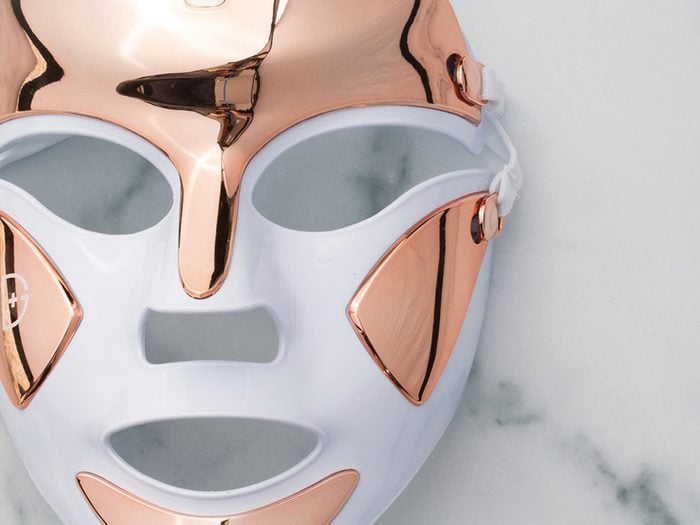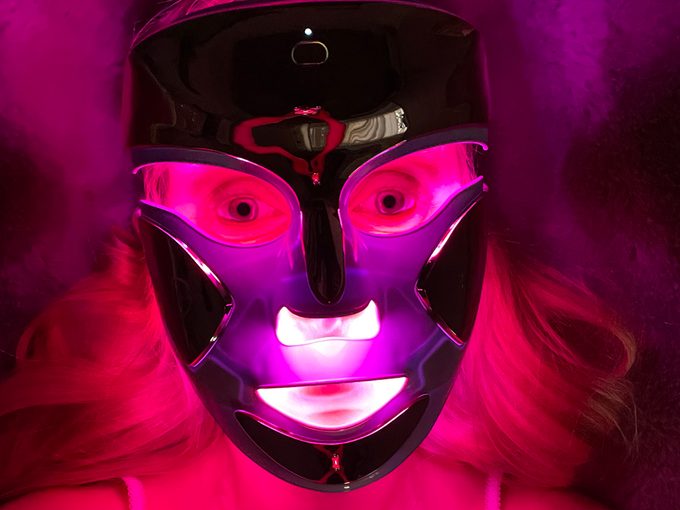Celebrities Love This At-Home LED Face Mask, So I Tried It Out

Digital editor Renée Reardin tried Dr. Dennis Gross’s LED face mask every day for four weeks. Here’s what happened.
For three minutes every evening, I lie on my couch with a Jason-esque mask placed over my just-cleansed skin while red and blue lights shine out of it and, allegedly, work their magic to give my skin the appearance of a line-free, blemish-free baby’s bottom. This is the latest innovation from Dr. Dennis Gross, a board-certified dermatologist and dermatological surgeon well known for his at-home peels). It’s the SpectraLite FaceWare Pro, which is an LED mask that uses red light to boost collagen and reduce fine lines, and blue light to kill bacteria to help heal and prevent future breakouts and redness.
I’m hardly the only one spending a few minutes a day this way. Celebrities like Paris Hilton and January Jones are fans of LED light therapy masks (with Jones opting for a substantially pricier version from Déesse). As are top aestheticians Sofie Pavitt and Melanie Grant (who’s also partial to the Déesse mask, as well as the even more expensive Dermalux mask). So how much can this thing actually improve my skin?
Light-emitting diode, or LED, masks “may stimulate collagen and elastin production, reduce skin inflammation and help kill bacteria contributing to acne,” says Monica Li, a board-certified dermatologist at City Medical Aesthetics Center in Vancouver. “But that’s depending on their wavelength.”
While at-home tools like Dr. Dennis Gross’s aren’t as powerful as professional-grade treatments (for safety reasons), they can be effective alternatives for some skin types with minor concerns, says Li, due to the frequency they can be used. For those who can’t afford—financially or for a lack of time —to visit the derm’s office a few times a month for a professional-grade treatment, an at-home version could be a more feasible option.
Li’s words to the wise: “LED can be safe for everyone, as long as the exact package instructions, maintenance care and warnings are followed.” She also suggests wearing medical-grade glasses or goggles when undergoing any LED treatment, as it can cause irreversible eye damage. Furthermore, for those with darker skin tones, Li recommends caution: “There is a possible risk of unwanted dyspigmentation due to skin inflammation.”
(Related: How to Give Yourself a Spa-Worthy At-Home Facial)

I’m supposed to start seeing results in two weeks. After one, I don’t notice a difference—but it’s not exactly the mask’s fault. Stress and hormones have caused me to be the current landlord of some indestructible blemishes that need time to heal. Although the mask’s blue light mode is intended to treat acne and prevent breakouts, it does so by killing bacteria that causes some forms of acne—but apparently not my kind. For these squatters, I’ve added meditation to my beauty routine.
After week two, my blemishes are finally starting to heal, and I haven’t had any new breakouts. Although I wouldn’t say my skin looks any better than it did before I started using the mask, it’s quick and easy enough to use, so I’m still game to keep this up until I (hopefully) start seeing results.
I’m beginning to believe my skin looks a little more even and smoother. I can’t see a significant improvement in my breakouts or fine lines—but I’ve received a boost of encouragement to continue using the mask every day. On the July 14 episode of the Breaking Beauty podcast, co-host Jill Dunn chatted with beauty blogger Lauryn Evarts Bosstick about the Dr. Dennis Gross LED light therapy mask and both agreed it’s worth the investment—financially and time-wise. Bosstick said with consistent use, the mask gave her a more even skin tone and soothed her psoriasis and Dunn said the mask improved her facial redness and acne.
By week four, I’ve picked up a couple of tips that also make me hopeful enough to continue LED-ing. First, Sofie Pavitt suggests applying a hydrating serum to the skin before wearing the mask, since LED is super drying. (I tried this, and it really helped.) And second, it might take more than four weeks to see results—Dr. Gross completed a clinical trial that found 97 percent of participants saw an improvement in fine lines, wrinkles, and skin tone after ten weeks of daily use.
What happens to my skin after 10 weeks? Unfortunately, nothing noteworthy.
It’s now been over a year since I wrote this piece—and about a year since I’ve used the mask. It just didn’t do enough for my skin to keep it in my everyday routine, though it was a fun ritual while it lasted. Onto the next skin care trend…
Next: What to Know Before Booking a Laser Treatment for Your Face




